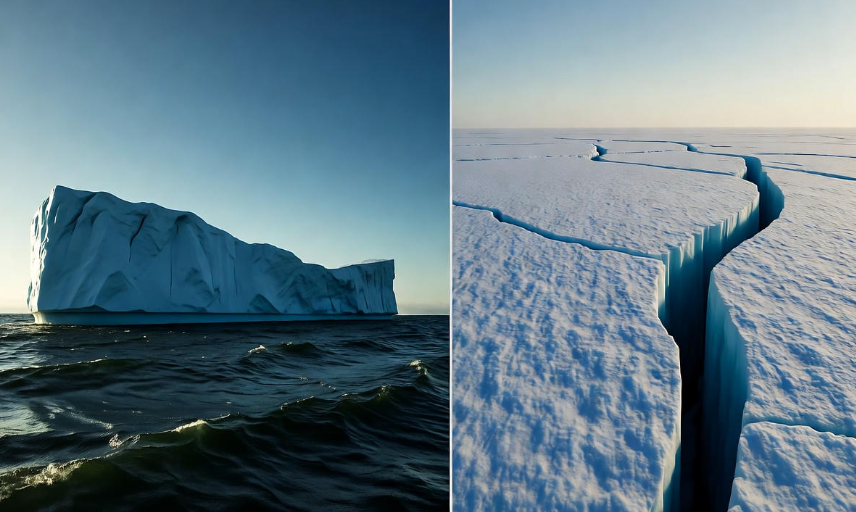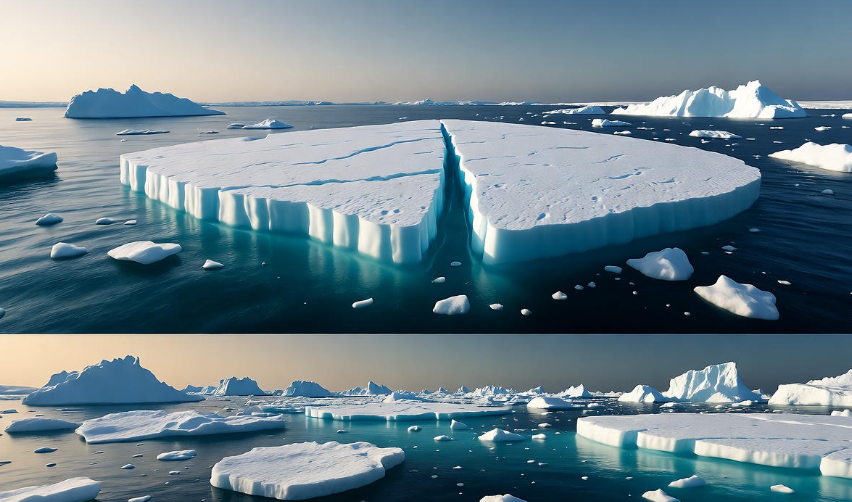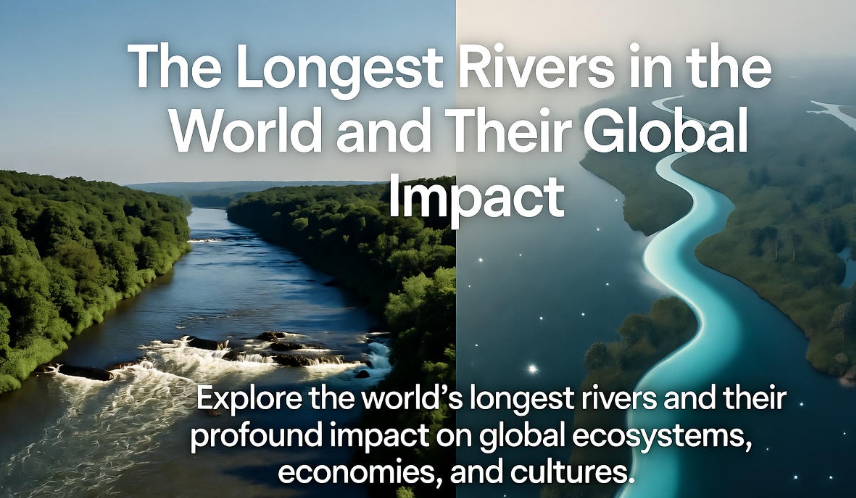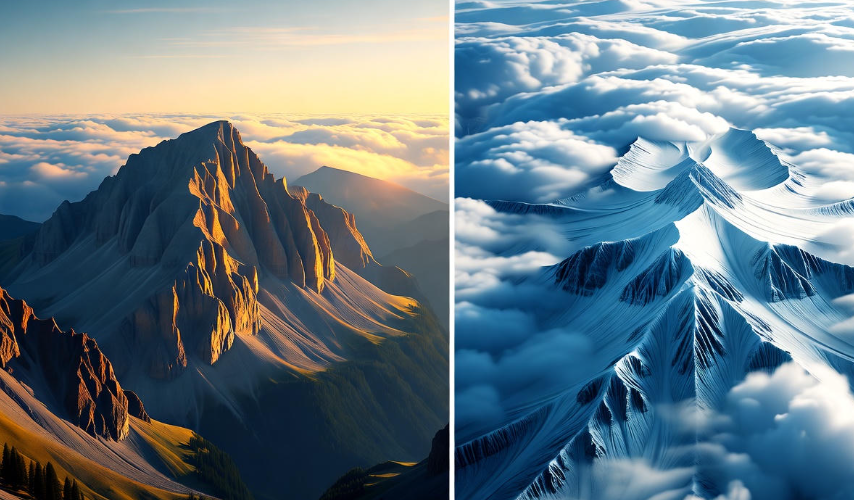The ice at the North and South Poles is disappearing at a pace that is alarming. And it’s not just “a little faster”—many indicators suggest it’s melting much faster than scientists expected even a decade ago. Let me walk you through what’s going on, why it matters, and what surprises researchers are finding.
What exactly is “melting faster”?
-
In the 1990s, Greenland + Antarctica together lost about 81 billion tonnes of ice per year. In the 2010s, that figure jumped to ~475 billion tonnes/year, a nearly six-fold increase. NASA Science+1
-
Sea ice extent (especially in the Arctic) has dropped by more than 10% per decade over the past 40 years during summer. National Geographic+1
These numbers show that it isn’t a small curve: it’s a steep climb.
Main reasons behind the rapid melting
Here are several forces working, often in combination, to accelerate polar ice melt:
| Factor | What it means / how it speeds up melt | Some nuance / surprising bits |
|---|---|---|
| Greenhouse gas driven warming | More CO₂, methane etc → traps more heat in atmosphere → higher air and sea temperatures. | It’s not just “hotter air above ice.” Warm ocean currents under ice shelves are also eating away ice from below. Deutsche Welle+1 |
| Albedo feedback | Ice and snow reflect sunlight. When ice melts, darker surfaces (ocean, land) appear. Dark surfaces absorb more heat → melt more ice. This is a positive feedback loop. | Also microbes/dust darkening ice/snow make albedo worse. This biological or physical darkening is being discovered as a strong factor, especially in places like Greenland. The Guardian+1 |
| Warmer oceans | Sea water temperature is rising. Warm water undercuts ice shelves, melts the edges, speeds up glacier flow into the sea. | Ocean currents matter. Some areas are worse because warm water is being pulled in more strongly. Also, as ice melts, freshwater flows change the dynamics. Deutsche Welle+1 |
| Arctic amplification | The Arctic warms much faster than the global average. A few degrees here mean more melting than the same degree rise elsewhere. | Why is amplification happening? Because ice loss, snow cover reduction, and changes in air and ocean circulation reinforce each other. Deutsche Welle+1 |
| Changes in weather patterns & climate cycles | Storms, wind patterns, jet stream shifts, more extreme events can bring warm air into polar regions, push ice toward melting zones, increase exposure. | Also, less cloud cover at certain times means more sunlight reaches the ice. Dust and aerosols influence cloud formation and how long snow stays bright. Space+1 |
| Thawing permafrost and release of warming gases | Frozen ground (especially in Arctic) stores organic carbon & methane. When it thaws, those gases release. That adds to warming, which in turn melts more ice. | This is another feedback loop: melt → release → more heat → more melt. Scientists are still trying to quantify exactly how big this is, but it’s real. Carbon Brief |
Recent Surprises & New Discoveries
Some things scientists didn’t fully appreciate before, or underestimated:
-
Microbes accelerating melt: Microbes living on snow/ice can darken ice (by pigment, trapping debris), reducing reflectivity so more sunlight is absorbed. In Greenland, this effect in some dark zones contributes significantly to melt. The Guardian
-
Dust & aerosols role: Dust from exposed land (as ice retreats) gets blown onto snow/ice, darkening it. Also clouds seeded by dust change in ways that reduce cloud cover or make clouds less reflective. Space
-
Melting deep into the ocean: Warm water under ice shelves isn’t just slowing melting, but rapidly undercutting huge portions of ice, causing structural collapse (icebergs, calving). This is especially dangerous in Antarctica. Deutsche Welle+1
-
Thresholds & tipping points: In many models, once warming goes past certain levels, feedback loops (like albedo, permafrost, ocean heat uptake) push melting into faster, hard-to-reverse modes. Some evidence suggests parts of Greenland may already be past such thresholds. Deutsche Welle+1
How much worse is melting now vs past decades
To understand the scale:
-
Gram for gram, we are losing much more ice now. The jump from ~81 billion tonnes/year in the 1990s to ~475 billion in the 2010s is huge. NASA Science+1
-
Summer Arctic sea ice shrinking >10% per decade. That means summers with much less sea ice, and possibly ice-free summers in some decades. National Geographic+1
-
Antarctica’s ice loss increasing (though regionally uneven) — some glaciers thinning fast, ice shelves weakening. National Geographic+1
Why this really matters
Because it’s not just “the Poles melting” in isolation. The effects ripple across the globe:
-
Sea level rise → coastal flooding, displacement of people, loss of land.
-
Weather changes → shifts in jet stream, more extreme weather far from the poles.
-
Loss of fresh water sources in some regions depending on glacier melt.
-
Ecosystem collapse: polar flora/fauna, species adapted to ice environments, may rapidly decline.
-
Amplifying climate feedbacks: once certain loops (like permafrost methane) kick in strongly, they make it harder to reverse warming.
Simple Table of Populations/Regions Most at Risk
| Region / Country | Why especially vulnerable | Potential impacts |
|---|---|---|
| Low-lying island nations (e.g. Maldives, Kiribati) | Rising seas eat away beaches & habitats | Loss of whole islands, forced migration |
| Coastal cities (e.g. New York, Mumbai, Bangkok) | Sea level + storm surges | Flooding, high costs for defenses |
| Arctic communities (Indigenous peoples) | Depend on sea ice + stable climate | Loss of livelihood, food sources, culture |
| Agriculture in Asia tied to Himalayan glacial melt | Depend on meltwater for dry season rivers | Water shortages, crop loss |
What can be done / steps people & governments are taking
-
Reducing greenhouse gas emissions (CO₂, methane etc).
-
Protecting and restoring ice-reflective surfaces, reducing soot and dust pollution.
-
Monitoring ice using satellites to detect early warning of tipping points.
-
Investing in climate adaptation: sea walls, relocation plans, flood warning systems.
-
Supporting research into feedback loops (like permafrost, ocean heat) so predictions improve.
-

Why the Poles Are Melting Faster Than Ever -
Dive deeper: How Geography Shapes Human Civilization
-
Summary thoughts (because sometimes you just need to pull it all together)
The poles are melting faster than ever because multiple factors are now combining: rising air and sea temperatures, feedback loops, biological and physical darkening, and changing weather/ocean patterns. Some of these accelerate each other.
We’re already seeing concrete losses—huge ice sheets losing mass, summer sea ice shrinking fast. And, what’s scary, there are signs we may be hitting thresholds. Once past those, many changes become much harder to slow or reverse.
It’s not a far-off worry. It’s happening. And what we do now (in emissions, protection, monitoring) will shape whether the worst effects can be avoided.
FAQs
Q: Are both the Arctic and Antarctica melting equally fast?
A: No. They behave differently. The Arctic (which is largely ocean ice surrounded by land) has warmed much faster than many parts of Antarctica. But some parts of Antarctica, especially its ice shelves and certain glaciers, are showing rapid thinning and retreat. Himalayas and mountain glaciers too are melting quickly. Deutsche Welle+1
Q: Does melting sea ice itself raise sea level?
A: Floating sea ice melting does not directly raise sea levels (because it’s already displacing water). But land ice (glaciers, ice sheets) melting into the ocean does. Also, when sea ice is gone, more heat gets absorbed, which indirectly speeds up melting of land ice.
Q: Is there a chance the poles will stop melting or reverse the melt?
A: Possibly—but only if strong actions are taken. Reducing emissions, slowing warming, limiting feedback loops. Some changes (like what’s already happened to ice shelves) may be hard to reverse. Time lags exist: ice, glaciers, permafrost respond slowly. Delay now makes reversal harder later.
Q: How soon might we see ice-free summers in the Arctic?
A: Some scientists project that if current emission patterns continue, the Arctic could have ice-free summers (i.e. very little sea ice) within 20–25 years. But that depends heavily on what we do globally. National Geographic
Q: Will melting polar ice affect people far from the poles?
A: Yes. Rising sea levels threaten coastal areas globally. Changing weather patterns (jet stream, storms) can affect temperature extremes, droughts, flooding in mid-latitudes. Freshwater resource changes can impact agriculture. Ecosystems everywhere get affected (sea level, ocean currents, biodiversity).




